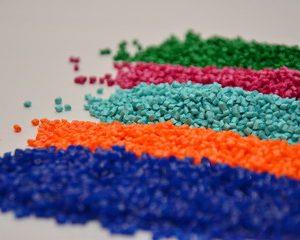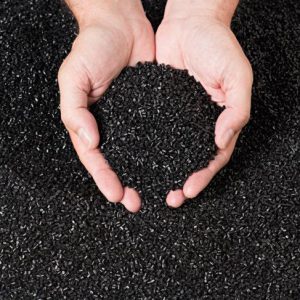Description
Polypropylene compounds are thermoplastic resins produced using a blend of one or more base polyolefins with various components such as impact modifiers, fillers and reinforcements, pigments and additives. These Polypropylene Compounds offer a broad range of characteristics and are used in a wide variety of customer applications for automotive, electrical appliances, building and construction and furniture components.
Polypropylene is similar to polyethylene in many ways, especially in solution behavior and electrical properties. The methyl group improves the mechanical properties and thermal resistance, although the chemical resistance decreases. In isotactic polypropylene, for example, methyl groups are located on one side of the carbon backbone. This arrangement creates a higher degree of crystallinity and results in a firmer material that is more resistant to creep than atactic polypropylene and polyethylene.
Polypropylene (PP) is a family of polyolefin polymers and is known today as one of the three most widely used polymers. Polypropylene has many plastic and fiber applications such as:
automobile industry
Industrial applications
Consumer goods
Furniture market
This material has the lowest density among commodity plastics. Depending on the position of the methyl groups PP can be polymerized to form three main chain structures:
Atactic polypropylene: Irregular methyl group arrangement (CH3)
Isotactic polypropylene: Methyl groups (CH3) located on one side of the carbon chain.
Syndiotectics: Alternating methyl group arrangement (CH3)
Types of polypropylene
Homopolymers and copolymers are the two major types of polypropylene on the market.
homopolymer Polypropylene
This material is the most widely used grade for general applications. Contains only propylene monomer in solid semi-crystalline form. The main applications of this material include: packaging, textiles, health products, pipes, automobiles and electricity.
copolymer Polypropylene
It is further divided into random copolymers and block copolymers produced by the polymerization of propene and ethane. Random polypropylene copolymer is produced by polymerization with both ethene and propene. These ethene units are randomly incorporated into polypropylene chains, typically up to 6% by weight. These polymers are flexible and optically transparent, and are suitable for use in applications that require transparency or for products that require excellent appearance.
While in polypropylene block polymer, the ethene content is higher. (Between 5 and 15%) have common monomer units that are arranged in a regular (or block) manner. Hence the regular pattern makes thermoplastic not harder and more brittle than random polymers. These polymers are suitable for applications that require high strength, such as industrial applications.
PP is useful in parts that need good impact resistance. Copolymers are mainly used in packaging, home appliances, films and pipes, as well as in the automotive and electrical sectors.
terpolymer Polypropylene
It consists of propylene segments joined together by ethylene and butane monomers (also monomers) and randomly appearing throughout the polymer chain. PP terpolymer has better transparency than PP homo. Also, the combination of monomers reduces the crystal uniformity in the polymer and makes it suitable for sealing film applications.
Polypropylene, high melt strength (HMS PP)
PP is a long-chain branching material that combines both high melting strength and flexibility in the molten phase. PP HMS grades have a wide range of mechanical properties, high heat stability and good chemical resistance. HMS PP is widely used in the production of soft and low-density foams for food packaging applications, as well as in the automotive and construction industries.
Disadvantages of polypropylene
Poor resistance to UV, impact and scratches
Low high service temperature at 90-120 ° C
Due to highly oxidizing acids, it swells rapidly in chlorine solutions
Poor paint adhesion
Applications of polypropylene
Polypropylene is widely used in various applications due to its good chemical resistance and weldability. Some common uses for polypropylene include:
packing
High strength, good surface area and low cost make polypropylene ideal for use in the packaging industry. The excellent light resolution of PP film and low vapor and moisture transfer make it suitable for use in food packaging. Other markets include shrinking small films, electronics industry films, graphic arts programs, disposable diaper tabs and closures, and more. PP Film is available as either Cast Film or BOPP with two axes.
This material is molded to produce boxes, bottles and pots. PP thin-walled containers are commonly used for food packaging.
Consumer goods
PP is used in many household products and consumer goods, including transparent parts, appliances, furniture, appliances, suitcases, toys, etc.
Automotive applications
Due to its low cost, outstanding mechanical properties and moldability, polypropylene is widely used in auto parts. The main applications include battery cases and trays, bumpers, fender liners, inner covers, tool plates and door covers. Other key features of PP automotive applications include low coefficient of linear thermal expansion and specific gravity, high chemical resistance and air resistance, processing and impact and hardness balance.
Fibers and fabrics
The large amount of PP used in the market segment is related to fibers and fabrics. PP fibers are used in various applications such as film, tape, belt, bulk continuous filament, spun bond and continuous filament. PP rope and string is very strong and moisture resistant, it is very suitable for marine applications.
Medical applications
Polypropylene is used in various medical applications due to its chemical and bacterial resistance. Also, PP medical grade has good resistance to steam sterilization. Disposable syringes are the most common medical application of polypropylene. Other uses include medical vials, diagnostic devices, petri dishes, intravenous bottles, sample bottles, food trays, pots, pill containers, and more.
Industrial applications
Due to its high tensile strength, high temperature resistance and corrosion resistance, PP sheets are widely used in industrial sectors for the production of acid and chemical tanks, sheets, pipes, RTP packaging, etc.
Biaxial polypropylene film
BOPP film is stretched in two directions, transverse and longitudinal, and produces the orientation of the molecular chain in several directions.
Orientation increases tensile strength and stiffness.
Good perforation and resistance to cracking over a wide range of temperatures
Excellent gloss and high transparency can be glossy, transparent, matte or metallic.
Efficient barrier against oxygen and moisture
Process Tips Related to PP
Polypropylene can be processed by all plastic processing methods. The most common processing methods are: injection molding, extrusion, impact molding and general purpose extrusion.
Injection molding
Melting point: 200-300 degrees Celsius
Mold temperature: 10-80 degrees Celsius
Drying is not necessary if stored properly.
High mold temperature improves the brightness and appearance of the part.
Depending on the processing conditions, the polymer rheology and the thickness of the final part, the volume reduction rate is 1.5 to 3%.
extrusion
For making pipes, impact and casting films, cables, etc.
Melting point: 200-300 degrees Celsius
Compression ratio: 3 to 1
Cylinder temperature: 180-205 ° C
Other methods of shaping
Compression molding
Rotary mold
Injection mold
Extrusion impact molding
Injection Impact injection molding
Extrusion for general purposes

